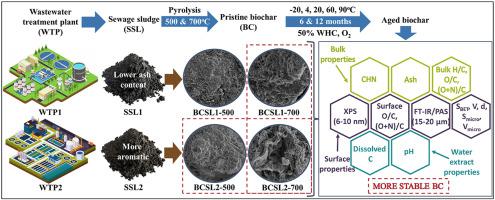Chemosphere ( IF 8.8 ) Pub Date : 2021-09-14 , DOI: 10.1016/j.chemosphere.2021.132258 Anna Siatecka 1 , Patryk Oleszczuk 1

|
The aim of this study was to determine the effect of abiotic aging of sewage sludge (SSL)-derived biochars on their physicochemical properties and in consequence on their stability. Biochars produced at 500 or 700 °C from SSLs with a different composition and properties were incubated at different temperatures (−20, 4, 20, 60, and 90 °C) for 6 and 12 months. Pristine and aged biochars were characterized in terms of their composition and properties using a range of complementary methods. The results showed that SSL-derived biochars will not be as stable as previously thought in the long term. The stability of the SSL-derived biochars was closely related to the content and character of C. The biochars that had more C in their composition and, apart from aromatic C, also aliphatic matter/carbon substances deposited in surface pores (i.e. those produced from SSL with a lower initial ash content and a lower degree of aromaticity) were less stable than the biochars with a lower C content and a typically aromatic character of C (i.e. those derived from SSL with a higher initial ash content and a higher degree of aromaticity). Their oxidation led to partial mineralization of aliphatic chains or organic surface film and manifested itself in a greater changes in their properties. The low-temperature biochars (BC-500) with lower aromaticity were found to be more susceptible to oxidation than the high-temperature ones (BC-700) with higher aromaticity. The more aromatic structure of C limited access of O2 molecules to biochar interior, due to which the processes occurring during aging were concentrated in their surface layer and their properties were less change. It can therefore be concluded that pyrolysis of SSL with higher aromaticity and a lower organic content and higher pyrolysis temperatures will lead to obtaining more stable SSL-derived biochars.
中文翻译:

不同成分和性质的污水污泥在不同温度下获得的生物炭的老化机理
本研究的目的是确定污水污泥 (SSL) 衍生的生物炭的非生物老化对其理化性质及其稳定性的影响。在 500 或 700 °C 下由具有不同成分和特性的 SSL 生产的生物炭在不同温度(-20、4、20、60 和 90 °C)下孵育 6 和 12 个月。使用一系列补充方法对原始和老化的生物炭的组成和特性进行了表征。结果表明,从长远来看,SSL 衍生的生物炭不会像以前认为的那样稳定。SSL 衍生的生物炭的稳定性与 C 的含量和特性密切相关。在其组成中含有更多 C 的生物炭,除了芳香 C 外,还有沉积在表面孔隙中的脂肪物质/碳物质(即 由具有较低初始灰分含量和较低芳香度的 SSL 生产的那些)比具有较低 C 含量和 C 的典型芳香特征的生物炭(即那些来自具有较高初始灰分含量和较高芳香度的 SSL 的生物炭)更不稳定芳香度)。它们的氧化导致脂肪链或有机表面膜的部分矿化,并表现在它们的性质发生更大的变化。发现具有较低芳香性的低温生物炭(BC-500)比具有较高芳香性的高温生物炭(BC-700)更容易被氧化。C的更多芳香结构限制了O的访问 那些源自 SSL 的具有更高的初始灰分含量和更高的芳香度)。它们的氧化导致脂肪链或有机表面膜的部分矿化,并表现在它们的性质发生更大的变化。发现具有较低芳香性的低温生物炭(BC-500)比具有较高芳香性的高温生物炭(BC-700)更容易被氧化。C的更多芳香结构限制了O的访问 那些源自 SSL 的具有更高的初始灰分含量和更高的芳香度)。它们的氧化导致脂肪链或有机表面膜的部分矿化,并表现在它们的性质发生更大的变化。发现具有较低芳香性的低温生物炭(BC-500)比具有较高芳香性的高温生物炭(BC-700)更容易被氧化。C的更多芳香结构限制了O的访问 发现具有较低芳香性的低温生物炭(BC-500)比具有较高芳香性的高温生物炭(BC-700)更容易被氧化。C的更多芳香结构限制了O的访问 发现具有较低芳香性的低温生物炭(BC-500)比具有较高芳香性的高温生物炭(BC-700)更容易被氧化。C的更多芳香结构限制了O的访问2分子到 biochar 内部,因此老化过程中发生的过程集中在它们的表层,并且它们的特性变化较小。因此可以得出结论,具有较高芳香性和较低有机含量和较高热解温度的 SSL 的热解将导致获得更稳定的 SSL 衍生生物炭。


























 京公网安备 11010802027423号
京公网安备 11010802027423号